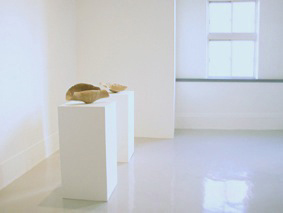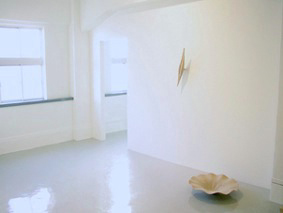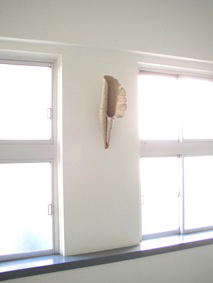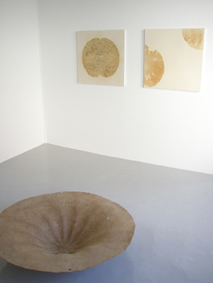morio nishimura, "suesser Regen (sweet rain)"nov. 9 - dec. 21, 2002taguchi fine art, ltd. |
||




|
Born in Tokyo in 1960, Morio Nishimura now resides in Meerbusch, Germany. After having graduated from Tama Art University in 1985, he moved to Germay as DAAD student in 1991. Got the Meisterschueler from Guenter Ucker at the Art Academy in Duesseldorf in 1995. Under the Japanese government overseas study program for artists, he studied on religion and contemporary art at the department of culture and spiritual history at the art academy in Johannes Gutenberg-University, Mainz from 1998 to 1999 and stayed there as a lecturer for two and half years. In 2001, received the title of "the artist of Kunst-Station Sankt Peter, Koeln 2001-02" . sweet rainAt taguchi fine art, ltd., installed are the works which Nishimura began to create after his emigration to Germany and continues to the present, titled "suesser Regen (sweet rain)". These works are wooden sculptures, of which motif is lotus leaves. His way of making these sculptures is very unique, first drawing a plan, next sawing plywood boards with contour lines according to the plan, then piling those plywood boards and glue them, and getting smooth curve by carving angles.Considering the fact that Nishimura chooses lotus leaves as the motif of his works and titled them "sweet rain", we understand that he has strong interest in Buddhism. It is believed that in celebration of the birth of Buddha, Ryu-oh (king of dragon) let "sweet rain" fall down to the earth, giving baby Buddha first bath. Even at the present time, we have ceremonies relating with this legend; At "Busshoe (a ceremony of the birth of Buddha)" at Todaiji temple, and "Kanbutsue" at many temples in various districts, priests are pouring sweet tea to the statue of newborn baby Buddha. Lotus is very important plant for Buddhism as the symbol of "Rin-ne (emancipation from worldly attachments)" or "Gedatsu (transmigration of the soul)". And also it is the sitting place of Buddha. Therefore this plant quite often appears as the motif of the Buddhist sculptures. The statue of baby Buddha is not exceptional, standing on the base representing lotus flower. relationship between human being and nature, worldAfter having settled in Germany, always confronting with his own identity as a foreigner from the far east, Nishimura clearly reaffirmed own interest in Buddhism and the philosophy of religion which was already in his mind. In the first two years in Germany, he decided not to create any art work and spent most of the time to deepen his own thoughts, reading books and being absorbed in meditation.In consequence, he got great suspicion of the modern epistemology which preaches that human is not being together with other existence but the ruler who recognizes the world from its outside. At the same time, he found a passage in Kegon sutra and deeply sympathized with it. That is "the universe, every life, mountains and minerals on the earth are all endlessly moving. Those movements are, whether big or small, depending on each other. Nothing is isolated. Human beings is also a part of nature, only one of the constituent elements". And then he found a basis of his activity in the idea of Zen, of which final destination is Gedatsu. Gedatsu is the attitude to inquire agressively the way to understand and associate with the outer world and to inquire ourselves being included by the outer world, approving the contradiction it has. This is the reason why Nishimura, when he resumed his creative activity, making art works, took lotus leaves which is the symbol of Rin-ne or Gedatsu as the motif of his new works. transparent congelation of ideaNishimura always tries to be aware of the energy in everything and every space, which exists regardless of its weight, and the responding relations in-between them. And when producing art works, he carefully proceeds, confirming the inter-penetration between the energy which he puts in or already lurks in the form he creates with his hands, and the energy in the outer space of the form.Followings are his word, "I have no wish to realistically represent or reproduce living lotus leaves. I take it as the motif for my work because it reminds me the idea of Rin-ne or the metaphysical existence as the universe. I am directly giving forms to them. In other words, my work is the transparent congelation of my idea in the form of lotus leaves." concern with general religious activityNishimura's concern is not only with the Buddhism. So far, on the occasion of the group show at the Ministry of Art and Culture, Port-Luis, Mauritius, "Made in Mauritius" in 1995, he made a Hindu temple with cement and mirror. At the Sankt Stephan Kirche in Mainz, "Kreuzgang" in 1998, made a wooden bed with fur devoted to Christ.For him, creating art works is not the ultimate purpose. Through taking various religious activities around the world as the motif of his works, Nishimura investigates into the relation between human being and the world. Nishimura is planning to have one man show at Kunst-Station Sankt Peter, Koeln in September - October this year. On November 9th, we had a lecture about "suesser Regen" and "lotus" by Mr. Yokoyama, priest at Kousokuji temple in Kamakura, and speech by the artist, coming back from Germany. |
|
| checklist of the installation | ||
| 1. "suesser Regen (sweet rain) nr.26", 1994, wood, 10.0 x 36.0 x 36.0 cm | ||
| 2. "suesser Regen-gesegnet", 1996, wood, 25.0 x 109.0 x 109.0 cm | ||
| 3. "suesser Regen nr.34", 1997, wood, 6.0 x 40.0 x 40.0 cm | ||
| 4. "suesser Regen F.H.2", 2000, wood, 18.0 x 15.0 x 39.0 cm | ||
| 5. "suesser Regen F.H.4", 2000, wood, 10.0 x 41.0 x 27.0 cm | ||
| 6. "suesser Regen F.H.8", 2000, wood, 14.5 x 60.0 x 60.0 cm | ||
| 7. "suesser Regen WS.10",1998, wood, 39.0 x 14.0 x 13.0 cm | ||
| 8. "suesser Regen WS.18", 2001, wood, 52.0 x 22.0 x 14.0 cm | ||
| 9. "suesser Regen WS.20", 2001, wood, 58.0 x 9.0 x 11.0 cm | ||
| 10. "untitled", 1997, lotus leaves, papr , 70.0 x 70.0 cm | ||
| 11. "untitled", 2000, lotus leaves, paper, 70.0 x 70.0 cm | ||